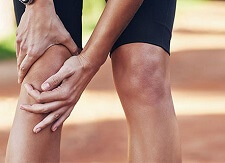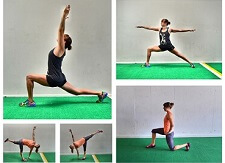- Home
- Knee Pain Diagnosis
- Swollen Knee
- Swelling Above Knee
Swelling On Top Of Knee
Written By: Chloe Wilson, BSc(Hons) Physiotherapy
Reviewed by: KPE Medical Review Board
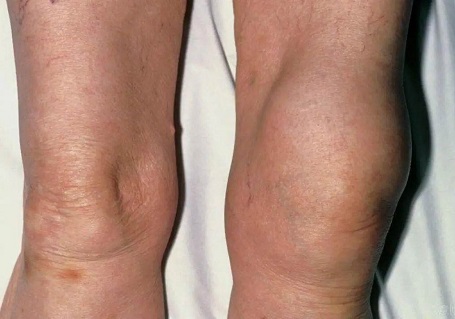
Swelling on top of the knee is a common problem.
Fluid may pool in the lower thigh, just above the kneecap or at the front of the knee, right on top of the knee cap.
There are lots of possible causes of swelling above the knee such as soft tissue injuries, underlying medical conditions and localised inflammation.
There may be a defined pocket of swelling, a hard lump above the knee or more generalised swelling around the knee. And the swelling may be constant or may fluctuate, depending on the underlying cause.
If the swelling is more around the kneecap than above it, check out the Front Knee Swelling article. Or if pain is more of a problem than swelling, check out the Pain Above Knee article.
Causes Of Swelling Above Knee
There are a number of possible causes of swelling on top of the knee and each will present slightly differently.
Here we start by looking at the five most common causes of swelling above the knee and the causes and symptoms of each. We will there go on to look at other possible causes of swelling above the knee and how to treat them.
1. Patellar Bursitis
The most common cause of swelling on top of the knee is patellar bursitis.
Bursa are small, fluid-filled sacs that sit between bones and soft tissues to allow the structures to glide smoothly over each other without any friction.
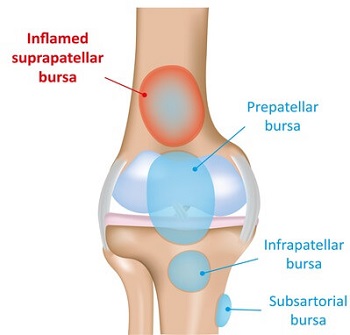
There are two bursa at the front of the knee that, when irritated, can cause swelling on top of the knee:
- Suprapatellar Bursa: sits between the thigh bone (femur) and the quadriceps tendon, just above the knee cap. Suprapatellar bursitis causes swelling above knee
- Prepatellar Bursa: sits directly in front of the kneecap. Prepatellar bursitis, aka Housemaid’s Knee, causes swelling on top of knee cap
Inflammation of the suprapatellar and prepatellar bursa is caused by repetitive pressure or friction on the bursa. Common activities that cause bursitis swelling on top of the knee include prolonged or frequent kneeling, squatting, jumping and kicking, particularly if the muscles at the front of the knee are tight.
The bursa produce excess fluid in an attempt to protect the knee from injury, which form pockets of swelling above or in front of the knee. With bursitis, the area of swelling is typically well defined and people often describe it as being like a squashy orange.
In most cases, swelling on top of the knee from patellar bursitis can be treated at home, but in some cases, your doctor may recommend further intervention. If there is significant swelling on top of the knee from bursitis, the fluid can be drained, known as aspiration, but it is important to address the underlying cause of the bursitis otherwise the fluid will recollect causing further bouts of swelling above the knee.
You can find out lots more about the causes, symptoms, treatment and prevention options in the Knee Bursitis section.
2. Quadriceps Tendonitis
Another common cause of pain and swelling on top of the knee is quadriceps tendonitis.
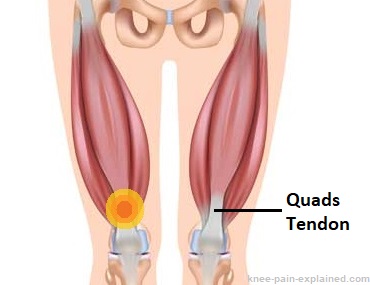
Quadriceps tendonitis is caused by inflammation and degeneration of the quadriceps tendon, just above the kneecap.
Strain and overuse of the quadriceps can lead to inflammation and tearing in the quadriceps tendon, resulting in pain and swelling above the knee.
In most cases, swelling on top of the knee from quadriceps tendonitis is due to overuse, typically with sports that involve quick starts, stops and turns, running and jumping e.g. basketball, tennis and football.
There are several things that can make you more prone to quadriceps tendonitis such as muscle imbalance, sudden increases in training levels, altered foot biomechanics and unsupportive footwear.
Quadriceps tendonitis tends to initially cause pain and tenderness just above the kneecap with activity. You may also so start to develop some swelling on top of the knee, just above the kneecap, particularly after physical activity e.g. running or sports. Over time, the knee may become stiff and weak.
Swelling above the knee from quadriceps tendonitis tends to be mild to moderate, localised and may fluctuate with activity.
In most cases, swelling on top of the knee from quadriceps tendonitis can be treated at home and will settle within a few weeks. But without proper treatment and sufficient rest, there may be further tearing in the tendon which can lead to moderate to severe pain and swelling above the knee and weakness. In severe cases, the tendon may rupture completely.
You can find out more about the causes, symptoms and treatment options in the Quadriceps Tendonitis section.
3. Patellofemoral Pain Syndrome
Another possible cause of mild swelling on top of the knee is patellofemoral pain syndrome, aka Runners Knee. But don’t let the name fool you – it is just as likely to affect office workers as runners!
With patellofemoral pain syndrome, there is a problem with how the kneecap glides up and down at the front of the knee. This places increased pressure and friction on the cartilage lining the back of the kneecap.
Symptoms usually develop gradually and typically include aching anterior knee pain and mild swelling on top of the knee cap and around the front of the knee. Some people also notice a grating/grinding sensation when moving their knee.
Patellofemoral pain syndrome is usually caused by a combination of muscle weakness and tightness, altered foot biomechanics and anatomy. Symptoms are typically worse when you first get up after sitting for long periods, or with prolonged activity, especially long distance running, walking/running downhill and coming down stairs.
You can find out all about the common causes, symptoms, diagnosis and best treatment options in the Runners Knee section.
4. Meniscus Tear
Swelling on top of the knee can also be due to a meniscus tear – the thick cartilage that line the knee joint.
Swelling above the knee from a meniscus tear can develop:
- Suddenly: with an injury. Typically occurs in sports involving quickly twisting to change direction, particularly when the foot is fixed to the ground through cleats/studs. Depending on the size and location of the tear there may be immediate swelling on top of the knee, or the swelling may build up over a couple of days
- Gradually: through wear and tear. Repetitive force and friction through the knee meniscus can lead to fraying and tearing of the meniscus. This is particularly common over the age of 50 as the cartilage becomes more brittle with aging and can tear from everyday use. In this case, the swelling often comes and goes
Knee swelling from a meniscus tear will vary depending on how large the tear is and which part of the meniscus is affected. Often there is generalised swelling on top of the knee and when you press on the area it often feels slightly “boggy” or “springy”. In some cases there may be a more specific area of swelling at the side of the knee.
You can find out loads more about the causes, symptoms and treatment options in the Meniscus Tear section.
5. Suprapatellar Plica Syndrome
If you can feel a lump above the knee cap, it may be from suprapatellar plica syndrome.
Plica are folds in the lining of the knee joint, known as the synovial membrane. Only around 10% of the population have knee plica and in most cases, they don’t cause any problems. But, if the suprapatellar plica which sits just above the kneecap get inflamed or irritated, then it can cause pain and instability in the knee.
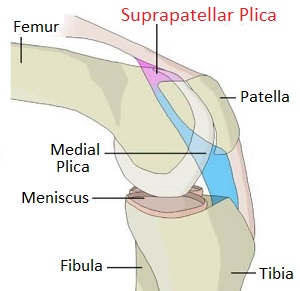
Suprapatellar plica syndrome occurs when there is excessive friction on the plica or if it gets squashed. This leads to inflammation in the plica which gradually thickens and can harden over time, forming a lump above the knee.
Typical activities which can lead to swelling on top of the knee from plica syndrome are a blow to the knee, activities requiring repetitive knee flexion/extension e.g. running and cycling or suddenly increasing your activity levels.
Muscle weakness, underlying medical conditions and previous knee injuries can make the knee more prone to plica syndrome.
There are four areas of knee plica and plica syndrome can develop in any of them
- Suprapatellar Plica Syndrome: causes swelling on top of knee
- Infrapatellar Plica Syndrome: causes swelling below knee
- Medial Plica Syndrome: causes swelling on inside of knee
- Lateral Plica Syndrome: causes swelling on outside of knee
In some cases of plica syndrome, adhesions may also form between the suprapatellar plica and the knee bones which can limit knee movement.
If you think this is the cause of you lump on top of your knee the find out more about treatment in the Knee Plica Syndrome section.
Other Causes Of Knee Swelling
So far we have looked at the five most common causes of swelling on top of the knee, but there are a number of other things that can cause swelling at the front and sides of the knee, as well as above it.
- Arthritis: Arthritis is a common cause of knee swelling due to inflammation and wear and tear in the knee joint. Rheumatoid arthritis is commonly associated with flare-ups and is a chronic inflammatory disorder which can affect the whole body. Osteoarthritis is commonly known as wear and tear arthritis caused by degeneration in the knee joint and the formation of bone spurs. Find out all about the common causes, symptoms and best treatment options in the Knee Arthritis section
- Gout: If the swelling on top of your knee is accompanied by redness, warmth and intense pain, you may be suffering from gout knee where uric acid crystals form in the joint. Symptoms tend to come on rapidly, often at night. Find out more about gout knee treatment
- Fracture/Dislocation: If a knee injury occurs under enough force, then it is possible to dislocate or fracture one of the bones which can cause severe swelling on top of the knee. There will usually be some obvious deformity with the swelling and intense pain, and medical attention should be sought as soon as possible. LEARN MORE >
- Tumor: Occasionally, swelling on top of the knee is due to a tumor e.g. synovial sarcoma. Tumors typically also cause symptoms such as fatigue and unexplained weight-loss
- Infection: if there is an infection in the knee joint e.g. septic arthritis, there may be excess fluid and inflammation which can lead to swelling on top of the knee joint. This is usually treated with antibiotics
Swelling Above Knee Treatment
The best treatment for swelling on top of the knee will depend on the underlying cause of the swelling, but the initial aim is to reduce the amount of excess fluid. Treatment for swelling above the knee will often involve a combination of:
- PRICE: protect, rest, ice, compression & elevation
- Medication: to reduce pain and inflammation
- Injections: a mixture of anaesthetic and corticosteroid is injected into the area to reduce pain and inflammation
- Aspiration: the excess fluid is removed with a needle
You can find out all about the different ways to reduce swelling on top of the knee in the Swollen Knee Treatment section.
Swelling on Top Of Knee Summary
There are lots of possible causes of knee swelling which all present slightly differently.
If there is a distinct pocket of swelling or lump on top of the knee it is likely due to suprapatellar bursitis, housemaids knee, suprapatellar plica syndrome or a quads tendon rupture.
If there is a hard lump above the knee, it may be due to knee bone spurs.
If there is mild to moderate swelling above the knee only, it is likely due to quadriceps tendonitis, meniscus tear or patellofemoral pain syndrome.
If there is more generalised swelling around the knee joint as a whole, it may be due to arthritis, a large meniscus tear or a ligament tear.
If the swelling above your knee is accompanied by redness and warmth, it may be due to gout, an infection or a DVT – seem medical assistance as soon as possible.
Swelling isn’t always confined to the top of the knee and different things cause knee swelling in different places. Find out more in the following sections:
- Swelling Behind The Knee: at the back of the knee
- Front Knee Swelling: around the kneecap
- Side Knee Swelling: on the inner or outer side of the knee
- Swelling Below The Knee: swelling below the knee into the lower leg
- General Knee Swelling: around the entire joint
- Pain Above The Knee: if pain is more of a problem than swelling
Page Last Updated: 21/09/23
Next Review Due: 21/09/25
